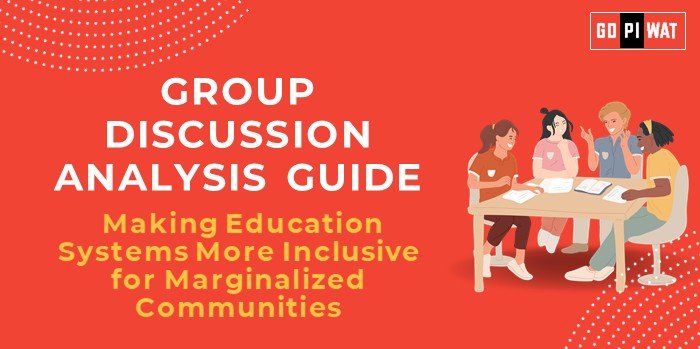📋 Group Discussion Analysis Guide: Making Education Systems More Inclusive for Marginalized Communities
🌐 Introduction to the Topic
Opening Context: Inclusive education is pivotal for fostering equitable societies and enabling sustainable economic growth. Despite global strides in education access, marginalized communities often remain underrepresented, highlighting a pressing need for systemic reform.
Topic Background: The concept of inclusive education originated from UNESCO’s Salamanca Statement in 1994, emphasizing equal opportunities for all learners. Recent global movements like the UN’s SDG 4 have spotlighted the urgency of addressing educational disparities.
📊 Quick Facts and Key Statistics
- Global Out-of-School Children: 244 million (UNESCO, 2023) – underscores the magnitude of educational exclusion.
- India’s Literacy Rate: 77.7% (NSO, 2023) – with marked gender and regional disparities.
- Dropout Rates: 17% at the secondary level in India (MHRD, 2023) – higher among marginalized groups.
- Special Needs Access: Only 1 in 4 children with disabilities attend school (World Bank, 2023).
👥 Stakeholders and Their Roles
- Government Agencies: Formulate inclusive policies (e.g., Right to Education Act, 2009).
- NGOs: Provide grassroots support and advocacy (e.g., Pratham, Teach For India).
- Educational Institutions: Adapt curriculums and infrastructure for diverse learners.
- International Organizations: Promote global standards (e.g., UNESCO, UNICEF).
- Communities: Foster local support systems and engagement.
🏆 Achievements and Challenges
Achievements:
- Right to Education Act (RTE): Ensured free primary education for all children in India.
- Midday Meal Scheme: Boosted enrollment by 10-15% among underprivileged children.
- Samagra Shiksha Abhiyan: Unified school education across sectors.
- Digital Learning Initiatives: E.g., DIKSHA and ePathshala in India, providing resources to remote learners.
Challenges:
- Infrastructure Gaps: 40% of schools lack essential facilities like toilets or ramps.
- Teacher Shortages: High pupil-teacher ratios, particularly in rural areas.
- Cultural Barriers: Discrimination based on caste, gender, or disability persists.
- Digital Divide: 70% of rural households lack internet access, limiting online education opportunities.
🌍 Global Comparisons:
- Finland: Exemplary in teacher training and individual learning support.
- South Africa: Combats apartheid-era inequities through targeted reforms.
Case Study:
Kerala Model: Achieved nearly 100% literacy through grassroots campaigns and robust state investment.
📚 Structured Arguments for Discussion
- Supporting Stance: “Policies like RTE have significantly improved access to education, especially for marginalized groups.”
- Opposing Stance: “Systemic barriers, including poor infrastructure and teacher shortages, undermine inclusivity efforts.”
- Balanced Perspective: “While strides have been made in enrollment, achieving true inclusivity demands addressing cultural and structural gaps.”
💡 Effective Discussion Approaches
- Opening Approaches:
- Start with compelling data: “244 million children worldwide remain out of school.”
- Use a case study: “Kerala’s near-universal literacy showcases what inclusive education can achieve.”
- Highlight a challenge: “Despite RTE, dropout rates remain high among tribal children.”
- Counter-Argument Handling:
- Acknowledge gaps in implementation.
- Propose solutions like vocational training or community participation.
🔑 Strategic Analysis of Strengths and Weaknesses
- Strengths: Policy initiatives, NGO involvement, global support frameworks.
- Weaknesses: Resource scarcity, implementation inefficiencies.
- Opportunities: Technology integration, global partnerships.
- Threats: Budget constraints, societal resistance.
🌍 Connecting with B-School Applications
- Real-World Applications: Use cases for development economics, education tech, and CSR projects.
- Sample Interview Questions:
- “How can public-private partnerships enhance inclusive education?”
- “Discuss the role of technology in bridging education gaps.”
- Insights for B-School Students:
- Exploring EdTech opportunities for inclusivity.
- Addressing systemic biases through community-based projects.


